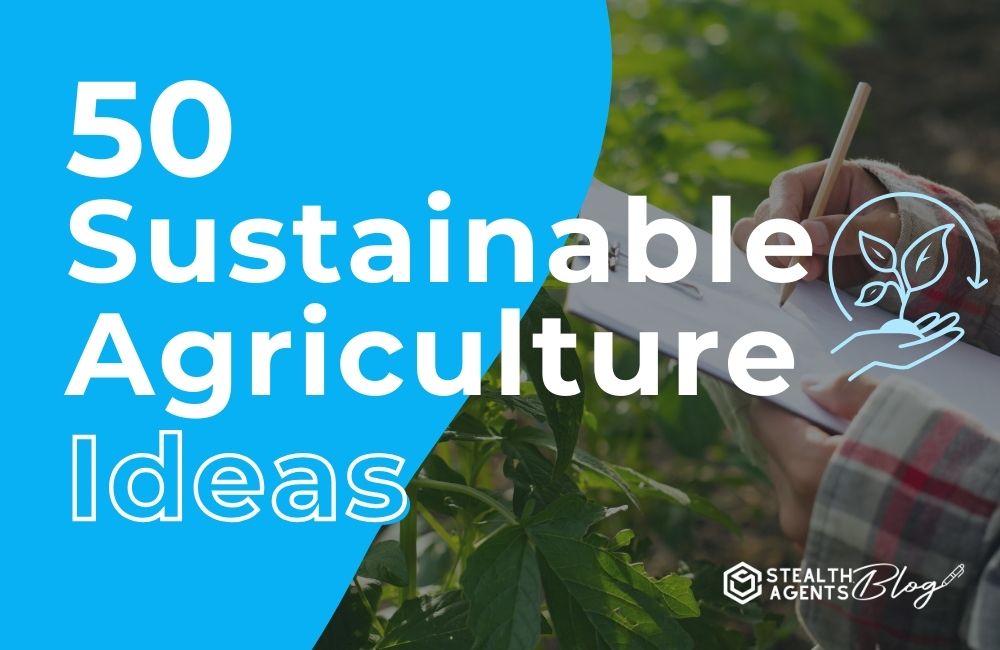50 Sustainable Agriculture Ideas
Sustainable agriculture is not just an environmental buzzword; it’s a call to action for farmers, consumers, and communities to harmonize with the Earth’s resources. As we face increasing challenges from climate change and dwindling natural reserves, adopting sustainable practices isn’t an option; it’s essential. Join us in exploring a treasure trove of 50 sustainable agriculture ideas that honor the soil, the environment, and future generations. It’s not just about what’s best for the planet; in many cases, it’s also what’s best for our health and our wallets.
Let’s dive into concepts that range from genius to grassroots, all with one common goal: a more sustainable and resilient food system. It’s a long list, but every idea shares a commitment to a future where agriculture flourishes without compromising the very land on which it depends.
Overview of Sustainable Agriculture
Before we start brainstorming our 50 ideas, let’s make sure we understand what sustainable agriculture is. In the broadest sense, sustainable agriculture is farming in a way that can be maintained over the long term without harming the environment, it being economically viable for the farmer and enhancing the quality of life for farmers and society as a whole. This involves a suite of practices that seek to minimize waste, environmental degradation, and pollution while supporting an equitable food system.
Why does this matter? Because traditional farming and industrial agriculture can deplete soils, pollute water, and result in the loss of biodiversity. But sustainable agriculture preserves the natural environment while producing high-quality food. It not only addresses our environmental concerns but can also increase the resilience of farms to a changing climate and improve the lives of people involved in agriculture.
Without further ado, here’s how you can contribute to a sustainable food future, whether you’re a backyard gardener or a major player in the agricultural industry.
1. Invest in High-Quality Soils
Soil is the foundation of sustainable agriculture, and boosting its quality can increase crop productivity and nutrient content. This can be as simple as using compost and mulch, or as advanced as no-till farming, cover cropping, and organic methods that enhance soil biodiversity.
2. Embrace Agroecology
Agroecology integrates ecological and social concepts with farming practices to create diverse, resilient agricultural systems. It’s not just about planting; it’s about creating a whole network of mutually beneficial relationships between crops and the environment.
3. Utilize Intelligent Irrigation
Water is a precious resource, and innovative irrigation techniques like drip systems and precision watering can optimize usage and minimize waste. Pair these with rainwater harvesting to further limit reliance on water tables.
4. Crop Diversity for a Resilient Farm
Diversifying your crops is like investing in a resilient portfolio. It helps farms to adapt to changing conditions, lessens the need for chemical inputs, and can even enhance nutrition for people and animals.
5. Low-External-Input Farming
Adopt farming systems designed to require minimal chemical and fossil-fuel inputs. This can include agroforestry, bio-intensive farming, and the use of locally-sourced animal feeds and fertilizers.
6. Explore Polycultures and Interplanting
Instead of mono-cropping, interplant a variety of crops in your fields simultaneously to mimic natural ecosystems and increase biodiversity.
7. Prioritize Perennial Crops
Perennial crops have longer growing seasons, deeper roots, and require fewer inputs than annuals. They’re not only good for the planet but can also be incredibly profitable for farmers.
*advertisement*
Tired & Overwhelmed With Administrative Tasks?
Hire A Top 1% Virtual Assistant From Stealth Agents!

Sign Up Below & Hire A Top 1% Virtual Assistant
Rated 4.7 Stars Serving Over 2,000+ Customers.
Hire Top 1% Virtual Assistants For $10-$15 Per Hour
Ask About Our 14 Day Trial!
*advertisement*
8. Use Integrated Pest Management (IPM) Strategies
Encouraging beneficial insects, rotating crops, and using trap crops are part of a holistic approach to pest management that minimizes the use of harmful pesticides.
9. Organic Fertilization
Moving away from synthetic fertilizers and adopting organic sources can contribute to healthier soils and reduce pollution of waterways.
10. Localizing Food Systems
Buying and selling locally reduces the carbon footprint of food. It also strengthens local economies and reduces food-miles traveled.
11. Community Supported Agriculture (CSA)
CSA programs offer a way for consumers to directly support local farmers by purchasing shares of the season’s harvest. This not only provides certainty for farmers but also creates a sense of community around food.
12. Agribusiness Incubators
These programs help new entrants to the agricultural sector get established, reducing the risk and cost that can come with starting a farming business. This is vital in providing access to farming for younger generations or those from non-agricultural backgrounds.
13. Agrotourism
Open up your farm for tourism to bridge the gap between consumers and producers and educate the public about sustainable farming practices.
14. Vertical Farming
Utilizing vertical space to grow crops can massively increase yield per square foot, often in controlled environment agriculture systems that use fewer resources than traditional agriculture.
15. Utilize Shelterbelts and Windbreaks
Strategic planting of trees and shrubs not only combats erosion and provides habitat but also shields crops from wind and helps to abate climate change.
16. Energy Efficiency on the Farm
Reducing energy usage through solar panels, wind turbines, and energy-efficient equipment can cut costs and carbon emissions.
17. Batch and Continuous Flow Composting
Composting can reduce waste, enhance soils, and capture greenhouse gases. Different systems suit different scales of operations.
18. Sustainable Livestock Management
Good livestock management is key. This includes rotational grazing, which improves soil health and reduces overgrazing, and practices that ensure the welfare of animals.
19. Agroforestry
Integrating trees with crops or livestock can have a multitude of benefits, from improving soil health to providing additional income streams from wood products.
20. Reduced Food Waste
Implement strategies to reduce waste at all points in the food production and consumption cycle. This could be through improved harvesting techniques, better storage, or creative ways to use ‘ugly’ produce that might otherwise go to waste.
21. Encourage Native Crop Cultivation
Promoting and preserving the cultivation of native crops is not only respectful of cultural traditions but also can enhance food security and the environment.
22. Seed Saving
Saving seeds and exchanging them with other farmers can preserve genetic diversity and create hardy, site-specific crop varieties.
23. Adopt No-Till Farming
This practice can reduce erosion, conserve soil moisture, and sequester carbon in the soil, working towards mitigating climate change.
24. Utilize Renewable Energy on the Farm
Investing in solar, wind, or hydropower can reduce a farm’s carbon footprint and long-term energy expenses.
25. Integrated Aquaculture
Co-cultivating fish with plants (aquaponics) or shrimp alongside rice fields improves resource efficiency and provides a synergistic system for aquatic and terrestrial plant growth.
26. Community Gardens
Providing urban spaces for residents to grow their own food fosters community, reduces food miles, and minimizes the urban heat island effect.
27. Regenerative Agriculture
Embrace practices like compost application, cover crops, and complex rotations to rebuild soil organic matter and restore degraded soil conditions.
28. Renewable Energy Crops
Explore the possibility of growing energy crops like switchgrass or willow for biofuels on less productive agricultural land.
29. Implement The “No Bare Ground Policy”
Keep the soil covered to reduce erosion, retain soil moisture, moderate soil temperature, and inhibit weed growth. Cover crops and mulches are your best friends here.
30. Utilize Local Breeds and Varieties
Adopting local breeds and varieties can be better adapted to local conditions and reduce the need for medications and other inputs.
31. Reforestation in Agriculture
Enhance carbon sequestration and preserve natural habitats by setting aside portions of your farm for reforestation.
32. Ecological Pest Control
Use pheromone traps, bird or bat boxes, and other natural predators to control pest populations without chemicals.
33. Agri-Waste Management
From crop residues to agricultural plastic, managing waste on the farm with recycling, composting, or responsible disposal is integral to a sustainable system.
34. Crop Wild Relatives
Understanding and preserving wild relatives of cultivated plants are important not just in plant breeding but also in maintaining the diversity of ecosystem services.
35. Farmer’s Markets
Direct consumer sales at farmer’s markets can cut out the middleman, increase the farmer’s share of the retail price, and reduce handling and packaging waste.
36. Water Harvesting and Management Systems
Developing ponds, swales, and terraces can manage water flow, recharge aquifers, and prevent erosion.
37. Participatory Guarantee Systems (PGS)
These offer an alternative to a costly and bureaucratic process of organic certification, and demonstrate that farmers adhere to certain sustainable and organic farming standards.
38. Accurate Pesticide Application
Use of precision agriculture to reduce pesticide drift, limit over-application, and protect the environment and beneficial organisms.
39. Utilize Advanced Technology
Drone technology, remote sensing, and big data can provide valuable insights into soil and crop health, helping farmers optimize their operations.
40. Value-Added Products
Processing foods on the farm or cooperatively to create value-added products can increase income while utilizing imperfect or surplus produce.
41. Active Participation in Policy and Advocacy
Farmers and advocates who fight for policies that support sustainable agriculture at the local, national, and international levels are essential to the movement.
42. Investment in Training and Education
Continuous learning and sharing of best practices for sustainable agriculture is key to its widespread adoption.
43. Support for Young and New Farmers
Investing in programs that mentor and financially support new farmers can rejuvenate the agricultural sector with fresh perspectives and enthusiasm for sustainable practices.
44. Allotment Gardens
These can provide individuals with a space to grow their own food, while also fostering a sense of community and shared learning.
45. Solar Dehydration
Using solar energy to dry food can be both sustainable and a tool for reducing post-harvest losses.
46. Mobile Slaughter Units
These can improve animal welfare and reduce stress by bringing the abattoir to the farm, as well as lessening the carbon footprint of transporting livestock.
47. Ecosystem Services Payments
Receiving payments for providing ecosystem services — clean water, carbon sequestration — can provide an extra revenue stream for farmers while aligning economic incentives with sustainability.
48. Nutrient Cycling
Understand and manage the flow of nutrients through the agricultural system to reduce the need for external inputs and prevent nutrient pollution.
49. Resilient Crop and Livestock Insurance
Develop and support insurance products that incentivize practices that build resilience and mitigate climate-related risk.
50. Advocating for Land Rights and Tenure Security
Secure land rights are fundamental for sustainable land use and investment in soil health and environmental management. Encouraging and advocating for these rights benefits not only farmers but the broader environment and society.
Conclusion
Sustainable agriculture is a journey, not a destination. With each of these 50 ideas, you contribute to a larger tapestry of change that benefits everyone. As farmers, consumers, and members of the global community, we have a role to play in nourishing a planet in a way that can sustain us all for the long haul. Let’s get growing!










